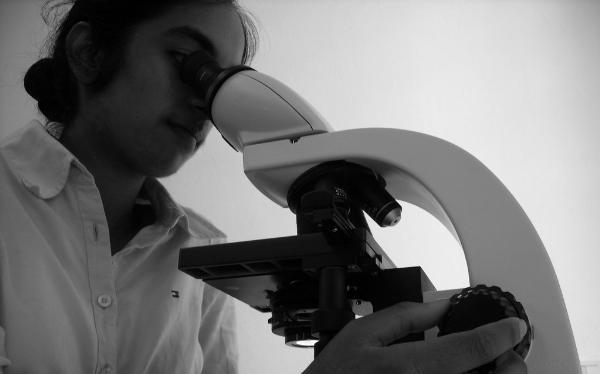In a three-part series for Thinking Faith, Michael Fuller, an Anglican priest with a background in organic chemistry, will challenge popular notions about the relationship between science and theology. In this first article, he looks at how a more traditional understanding of the practice of science has been called into question in recent years. What developments have occurred in the philosophy of science, and what might this mean for its engagement with theology?
Modern studies of the relationship between theology and science are now nearly half a century old, and may be dated back to a seminal work by Ian Barbour, Issues in Science and Religion, first published in 1966. Further pioneering work was done in the 1980s and 90s by people like John Polkinghorne, Arthur Peacocke and Paul Davies; and this topic has lately been something of a boom area in universities in Europe and America. It’s helpful to begin our exploration of this territory with some very simple questions: What is religion? What is science? How can they interact?
Words like ‘science’ and ‘religion’ are bandied about an awful lot, and can mean a variety of different things depending on how different people use them. ‘Religion’, in particular, is a notoriously difficult term to pin down, to the extent that virtually any definition of it immediately begs questions. Since ‘religion’ is so difficult to define, many writers in this field talk of ‘theology’ instead. Now ‘theology’, too, is a much-misused term. A few months ago, I heard a politician being interviewed on the radio saying of his opponent: ‘He is talking theology: I’m dealing with facts’. ‘Theology’, in popular parlance, has come to stand for fanciful, speculative thinking, unconnected to reality. In fact, of course, both historically and in the present day, theologians are as tenacious and rational in pursuit of their discipline as are any others who engage in intellectual discourse. So, what do we mean by ‘theology’? Again, different traditions would understand this word in different ways, but generally ‘theology’ seems to signify a way of thinking, of applying our rational selves to the asking of questions about God, and about the relationship of God with the Universe we see around us – and with ourselves, as a part of that Universe. St Anselm described theology as fides quaerens intellectum, ‘faith seeking understanding’, a description which many have found helpful.
The word ‘science’ is similarly bandied about in a variety of ways, but probably the most helpful is that which sees it as a method, as a way of interrogating the world around us, which generates data of a particular kind. If one thinks back to the late nineteenth century, the understanding that people then had of such a scientific method – an understanding which persists in many people’s minds to the present day – would be something along the following lines.
First, science is rational: it involves the exercise of reason and logic, not imagination and fantasy. Second, it is objective: if I perform an experiment, it will generate the same results, within the limits of experimental error, as you will get if you do the same experiment under the same conditions. Third, science is inductive: that is to say, it takes lots of observations and draws general conclusions from them. Fourth, it is deterministic: it assumes the universe functions in regular law-like ways, with effects following causes in predictable fashion. And fifth, science is reductionistic: that is, reality is to be sought by probing downwards into things, finding out what they are made of, and the behaviours of complex wholes are to be understood in terms of the behaviours of their component parts.
Interestingly, all these characteristics of science have been held up for questioning, by philosophers and by scientists themselves, over the last century or so. If we take each of them in turn:
(i) Rationality. Science is, of course, about applying rational principals to our study of the world. But the history of science shows us that scientific progress is by no means determined solely by rational factors. There are two ways in which we can see this. First, scientists sometimes solve problems not by logical reasoning, but by intuitive leaps of the imagination. A classic example of this is from my old discipline of organic chemistry. There is a famous story – the details of it are disputed, but it is still much-retold – relating to the way in which the French chemist August Kekule solved a particular problem of his day regarding the structure of the benzene molecule. The formula of this substance was known to be C6H6, which should make benzene very reactive, but in fact it is nowhere near as reactive as might be expected. Kekule proposed that benzene has a ring structure, rather than the linear structure that had been supposed up until then: a solution which admirably solved the problems presented by this compound. However, this solution wasn’t worked out rationally by Kekule, but rather (the story goes) it came to him in a daydream, whilst he was watching smoke rings rise from an open fire.
The second way in which science does not proceed simply according to its own rational lights arises because science is not something that proceeds in isolation from wider society. There are all kinds of experiments that could be done; but we decide which ones are to be done, and which ones aren’t, on the basis of the allocation of grants, the giving or withholding of ethical approval for experiments, and so on. Rational arguments will, of course, be used in making decisions of this kind; but they belong to the spheres of ethics, politics and economics, rather than to science per se.
(ii) Objectivity. Scientists are, of course, as objective as possible in the ways in which they approach their experiments; but it is inevitably the case that not all people will see the same things on looking at the same experiment. A writer called Michael Polanyi once commented, ‘Making sense of experience is a skilful act, which impresses the personal participation of the scientist on the resulting knowledge’: in other words, the same data do not present themselves in the same way to everyone, and the skill of the individual has an important role to play in selecting those data which are relevant. People have to be trained to know what it is that they are looking for in making observations: observations don’t simply happen.
In addition to this, we may note that in the strange and counter-intuitive field of quantum mechanics it is maintained that it is the observation of systems which exist in a superposition of states that makes them collapse into one state or the other. We cannot simply dispassionately scrutinise such systems from the outside: the very act of our looking draws us in and makes us a part of the system. (More on the quantum world in a later article.)
(iii) Induction. The inductive method is the means whereby we make a lot of observations and from them deduce general principles that explain those observations. This may appear unobjectionable; however, as David Hume pointed out a long time ago, it is in fact impossible to prove anything conclusively by this method, because a future observation may disprove any conclusion you have made based on previous ones. And in actual fact the most interesting science tends to happen when observations are made that can’t fit into existing hypotheses about the way things are.
The classic response to this is that of Karl Popper, who urged that science should properly proceed the other way around: by a method which involves setting up general hypotheses and deriving from them specific statements which may then be tested – and proved false. A ‘scientific statement’, on this understanding, isn’t a statement that has been proved true (because the inductive method can’t prove anything to be true in this way): it is, rather, a statement that may be proved false. Popper’s ideas remain the focus of much discussion, but his is perhaps the best way of drawing a line of demarcation between science and non-science.
(iv) Determinism. It is a commonplace notion that science presumes a deterministic outlook: that events will follow causes in law-like and predictable ways which it is the task of the scientist to tease out, and understand. However, science over the last century or so has presented problems for this understanding, at two levels. First, at the quantum level it appears that events take place which are uncaused. Quantum systems may obey statistical laws, but we can’t say how a particular subatomic particle will behave on anything other than a probabilistic basis. Second, even in large-scale systems there is an inescapable problem associated with measurement. No matter how accurate our measuring apparatus is, there will always be a small error in the measurements we make; and it transpires that in complex systems this error is rapidly magnified to the extent that the system becomes to all intents and purposes unpredictable. Indeed, it has been shown that inaccuracies creep into our measurement of systems even if we neglect the gravitational attraction (the weakest of the natural forces) of an electron (the smallest of the fundamental particles) at the far side of the observable universe. These two observations – quantum indeterminacy, and the measurement problem – demonstrate that the nineteenth-century deterministic vision is unachievable from both a theoretical and a practical point of view.
(v) Reductionism. What about my final nineteenth-century understanding of science – that it is reductionistic? This is the method which tries to understand complex wholes in terms of the operations of their parts. If you want to know how bodies work, you look at the organs they contain; if you want to understand organs, you look at cells; to understand cells, you look at complex biochemicals; to understand biochemicals, you look at simple molecules; to understand these you look at atoms; to understand these you look at nucleons; and so on. Understand the behaviour of the bits and you understand the behaviour of the wholes. This idea lies behind the extravagant language used by Richard Dawkins when he talks about genes, saying, for example, that they are the masters and we human beings (like all other organisms) are their ‘survival machines’. However, it’s increasingly being realised that there are some phenomena (including many very interesting ones) that simply aren’t reducible in this way. For example, water is wet; but this is a meaningless thing to say of a water molecule. A cell is usually described as being ‘alive’: it eats and reproduces; but this is a meaningless thing to say of any of the component parts of which it is made. Qualities such as wetness and life are sometimes said to be emergent phenomena within the more or less complex physical systems in which they occur. Reductionism as a research strategy can be very useful; but observations like these mean, I think, that we should be rather wary of the suggestion that the success of such strategies means that we can say the Universe consists of ‘nothing but’ the smallest things of which it is made. The emergence of novel phenomena at higher levels of complexity suggests that this is too simplistic a way of viewing things.
All these reflections should serve to remind us of the importance of thinking about what exactly science is, if we are to consider seriously its status as a method for generating knowledge, and how it might interact with other disciplines, such as theology. And the result of such reflections may lead us to see that science and theology are not so radically different, after all. So, with these considerations in place, let us turn to the question of how science and theology can inter-relate. Probably the most celebrated way of considering this question is the four-fold paradigm devised by Ian Barbour.
The first way in which science and theology can interact, according to Barbour, is conflict, or opposition. Science and theology are, as it were, in competition with each other over the same theoretical territory. One must be right, and the other wrong. This, of course, is the line taken by a number of popular commentators in the media, for whom conflict of any kind is always more interesting than consonance (presumably, because it sells better). More productive approaches, however, are both possible and desirable.
The second way is independence. This is the view that science and theology are both important, and both have important things to say to us; but they operate in fundamentally different territories. The naturalist Stephen Jay Gould, an exponent of this view, wrote of ‘non-overlapping magisteria’: science explores how the world works, and the physical and biological processes that have led to it coming to be the way it is, whilst theology explores the domain of values, and of ultimate meaning. Another characterisation of this approach is to say that science deals with ‘how’-type questions and theology deals with ‘why’-type questions. This is an attractive position in many ways; but it seems to deny that any fruitful interaction between science and theology is possible. They are exploring different domains, using different techniques.
That leads to the third way in which these disciplines might interact: dialogue. This is the view that an understanding of the sciences can be valuable in informing the way in which we do theology; and reciprocally, an understanding of theology can inform the way in which scientists do science. More obviously, perhaps, it is clear that a sense of values (which Gould assigns to the magisterium of theology) will inform the practice of scientists, since it lies behind any ethical codes which govern their behaviour. A number of commentators on the relationship between science and theology in recent decades have favoured this dialogical approach.
The fourth way in which science and theology can interact, according to Barbour, is integration. Barbour believes that it should be possible for insights from both these disciplines to be united to generate what he calls an ‘inclusive metaphysics’. Other writers have been less keen than Barbour in pursuing this path, since they fear (and experience tends to show) that it can lead rather to the assimilation of one or other of these disciplines under the categories of the other, inevitably failing to do proper justice to the discipline which is assimilated.
Despite this recognition that there can be a number of ways of viewing the relationship between science and theology, there appears to be a common perception that these disciplines are radically different, and that they must be opposed to one another. How they came to be seen this way is in itself an interesting topic, as we shall see in my next article, which will explore the origins of the ‘conflict myth’. We will then conclude this short series by looking at some consonances – some positive interactions – between science and theology.
Dr Michael Fuller studied Organic Chemistry at Oxford and Theology at Cambridge before being ordained into the Anglican Church. He worked in parishes in England and Scotland before taking up his present post at The Theological Institute of the Scottish Episcopal Church. He is Honorary Fellow of New College, University of Edinburgh and is the author of Atoms and Icons (Mowbray, 1995).
This article, and two more which will follow, originated in talks delivered at the Lauriston Jesuit Centre, Edinburgh, in May 2010.
![]() Science and Theology: Flashpoints
Science and Theology: Flashpoints
![]() Science and Theology: Consonances
Science and Theology: Consonances






